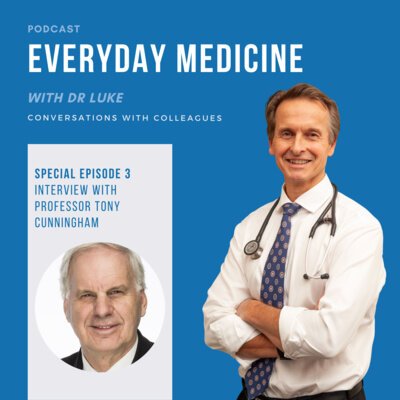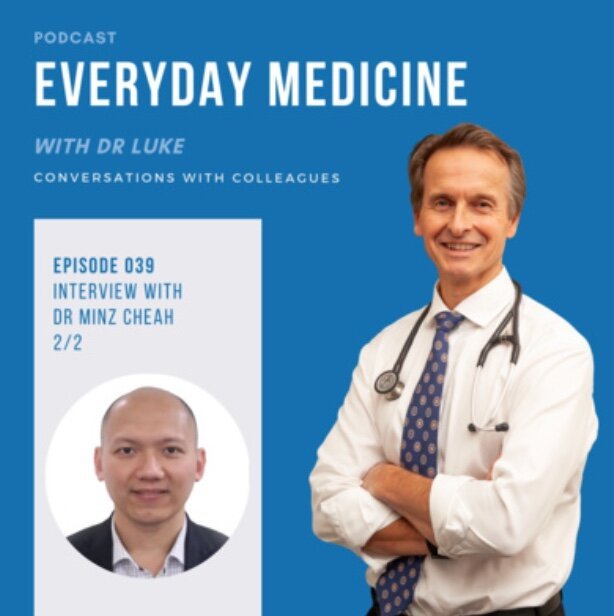Everyday Medicine by Dr Luke Crantock
Conversations with colleagues providing helpful ideas and advice in healthcare
Episode 50. Otalgia with Mr Adnan Safdar
Ear pain or otalgia as a diagnostic problem presents commonly to primary health physicians. Otalgia may be primary, arising from the external auditory canal (otitis externa) or the middle ear (otitis media) or secondary. As the sensory innervation of the ear is richly supplied by branches of the trigeminal, facial, glossopharyngeal, vagal nerve as well as upper cervical nerves it is not surprising that many secondary causes of earache including TMJ dysfunction, dental infections and neoplasias may also be responsible for otalgia.
Episode 49. IBS with Dr Catherine Sorrell
Irritable bowel syndrome is an idiopathic clinical entity characterised by chronic (more than six months) abdominal pain that occurs in association with altered bowel habits. In 2016 the Rome IV Consensus report adjusted the diagnosis to include symptoms occurring at least once a week from a previous definition of three times a month and include the notation of abdominal pain rather than discomfort related to defaecation. In practical terms, irritable bowel syndrome is in part a diagnosis of exclusion, however, in younger patients without alarm symptoms a simple stool test for calprotectin rather than extensive endoscopic work up may be all that is required. A negative calprotectin favouring conservative and symptomatic management, a positive finding requiring further workup.
Episode 48. Eosinophilic Oesophagitis with Dr Darcy Holt
Now recognised as one of the most common conditions underlying food impaction events, eosinophilic oesophagitis (EOE) has an estimated prevalence of 0.4% among both children and adults. EOE is a chronic inflammatory disorder characterised by oesophageal dysfunction and eosinophil predominant inflammation. Relatively recently described we may speculate as to whether this is a truly new disease or a more recently recognised one.
Special Episode 6. Mental Health in a time of Covid (and the polyvagal ladder) with Brenda Sutherland
Mental health has become a major casualty of the Covid pandemic that has swept across the globe and been responsible for rolling lockdowns throughout Australia restricting personal freedoms, social contact and the ability to prosper financially. No one is exempt from this unprecedented event and the anxiety, depression and anguish wrought is having a major effect on the health and wellbeing of our communities.
Episode 47. Helicobacter Pylori with Dr Darcy Holt
Helicobacter pylori is a gram-negative curved bacillus that may colonise the gastric and proximal duodenal mucosa. Its significance was first described by Barry Marshall and Robin Warren in 1982 both of whom were awarded the Nobel prize in 2005 after the Nobel community described the discovery as the most impacting in medical sciences. Most medical practitioners are aware of the pathophysiological consequences of Helicobacter which is responsible for gastritis, gastric and duodenal ulcer disease, and may be associated with gastric adenocarcinoma as well as mucosa associated lymphoid tissue hyperplasia (MALT lymphoma). Its eradication has largely hinged on standard triple therapy including a PPI combined with amoxicillin and clarithromycin taken together for 1 week in Australia; unfortunately this regimen has a 10-15% failure rate.
Special Episode 5. Psilocybin assisted psychotherapy with Dr Margaret Ross
The burden of mental health to Western society ranks amongst the leading causes of overall clinical presentations and the impact of anxiety, depression, addiction, substance abuse and PTSD can be devastating both to individuals and society. Recognition that psychedelic therapies may offer a profound benefit in the treatment of these conditions has rekindled a renaissance in their use, in particular of psilocybin from Psilocybe cubensis or “magic” mushrooms. The Australian Psilocybin Assisted Psychotherapy study at St Vincent’s focusing on end of life anxiety and depression is providing fascinating insights into the place and future use of these compounds.
Episode 46. Obstructive Sleep Apnea with Dr Michael Ho
Obstructive sleep apnoea is common, it is estimated that 49% of men aged 40-69 have obstructive sleep apnoea rising to 62% above the age of 70. Up to 1 in 10 have undiagnosed obstructive sleep apnoea which may present with snoring, daytime somnolence, depression and significant hypoxemia during sleep with associated cardiac arrhythmias.
Episode 45. Asthma with Dr Michael Ho
Australia has one of the highest rates of asthma in the world affecting about 11% of the population and in 2017/18 was responsible for 38,792 hospital admissions and 389 deaths, many of which may have been preventable. Asthma occurs when there is reversible expiratory constriction of the airways, especially the bronchioles and smaller bronchi, in response to various stimuli associated with a chronic inflammatory process. Today we are joined by Dr Michael Ho, an experienced respiratory physician who discusses:
Episode 44. Thyroid Nodules with Mr Cyril Tsan
Thyroid nodules are common, in some ultrasound series at least 30% of adults are found to have nodules and 4-7% of adults will have a palpable nodule. Whilst the overall risk of malignancy within a nodule is less than 5%, this is dependent on thyroid imaging reporting and data system (TI-RADS) which reflects features such as size of the nodule, presence of microcalcification, cyst complexity, whether the cyst is taller than wider and the presence of intranodular vascular images.
Special Episode 4. Covid-19: My Indian Experience with Dr Shashikanth Manikappa
In this episode, we share an intimate conversation with Dr Shashi Manikappa who has spent the past 18 months in India’s heartland volunteering medical care to those affected by the Covid pandemic. Whilst over 400 million Indians have received at least one dose of vaccine to date, on the ground in India treatment protocols embracing the use of Ivermectin in combination with other drugs have gained significant popularity and anecdotal support as an effective treatment. Shashi discusses the value of these protocols as used in India and the medical experience and perspective gathered during his time there. It is acknowledged that the protocols discussed in this episode have not been endorsed for use in Australia.
Episode 43. Radiofrequency Ablation with Dr Matthew Swale
Radiofrequency ablation (RFA) has revolutionised treatment for tachyarrhythmias and has become first line treatment for some tachycardias. Some arrhythmias are relatively common, atrial fibrillation for example affects up to 9% of our population over the age of 80 years and provides a very significant risk for thromboembolic stroke, haemorrhagic stroke as well as impairment of quality of life whilst also contributing to heart failure.
Episode 42. Atrial Fibrillation and DOAC's with Dr Matthew Swale
Atrial fibrillation is the most commonly experienced arrhythmia increasing in prevalence with age. It is estimated that 3 in 1000 under the age of 65 years have atrial fibrillation rising to 9% of people reaching the age of 80 years. The rate of stroke in untreated atrial fibrillation ranges from 5% per year with minimally associated risk factors up to 15-20% per year with associated risk factors such as hypertension, diabetes mellitus, heart failure and a history of vascular disease. The mortality of atrial fibrillation related to stroke is high and estimated at 25% in 12 months.
Special Episode 3. COVID-19 Vaccines with Professor Tony Cunningham
As the Covid pandemic continues to spread around the world with over 187 million recorded infections and 4 million deaths, countries including Australia have embarked upon vaccination programs including the use of mRNA (Pfizer and Moderna), viral vector (Astra Zeneca), and subunit protein vaccines (Novovax).
Episode 41. Secondary Prevention of Cardiovascular Disease with Dr John Counsell (Part 2)
Heart disease affects one in six Australians with an AMI occurring every 10 minutes and accounts for one in four of all deaths, so primary and secondary prevention are very important considerations in relation to any patient presenting with heart disease or at risk of heart disease. Risk factors including family history, lipid abnormalities, diabetes mellitus, hypertension, smoking or those with elevated BMI all need consideration. Whilst there have been significant controversies regarding lipids management and the use of statins, the evidence for their use, particularly in secondary prevention of heart disease is clear.
Episode 41. Primary Prevention of Cardiovascular Disease with Dr John Counsell [Part 1]
Heart disease affects one in six Australians with an AMI occurring every 10 minutes and accounts for one in four of all deaths, so primary and secondary prevention are very important considerations in relation to any patient presenting with heart disease or at risk of heart disease. Risk factors including family history, lipid abnormalities, diabetes mellitus, hypertension, smoking or those with elevated BMI all need consideration. Whilst there have been significant controversies regarding lipids management and the use of statins, the evidence for their use, particularly in secondary prevention of heart disease is clear.
Episode 40. Mole mapping and skin cancer surveillance with Dr Archie Xu
Non-melanotic skin cancers and melanoma are the most common cancers affecting humans. At least two in three Australians will be diagnosed with skin cancer before the age of 70 years and the risk is higher for men than women. Whilst basal cell carcinomas and squamous cell carcinomas are more common they are not as lethal as melanomas which are referred to as Australia’s “national cancer”. Indeed in 2020 it is estimated that 16,200 will be diagnosed with melanoma, that is one new case every half hour and a death every five hours.
Episode 39. Muscle Joints Aches and Pains with Dr Minz Cheah
Based on the Australian Bureau of Statistics National Health Survey data about one in three people over the age of 18 living in Australia have hypertension or were taking blood pressure lowering medications. A staggering number requiring therapy for a condition which impacts on cerebrovascular disease, coronary artery disease, chronic kidney disease, heart failure and mortality.
Episode 38. Hypertension with Dr Minz Che
Based on the Australian Bureau of Statistics National Health Survey data about one in three people over the age of 18 living in Australia have hypertension or were taking blood pressure lowering medications. A staggering number requiring therapy for a condition which impacts on cerebrovascular disease, coronary artery disease, chronic kidney disease, heart failure and mortality.
Episode 37. Why We Get Fat And What We Can Do About It with Professor Joseph Proietto
The western world faces a very significant obesity epidemic. In Australia, two-thirds of our population or 12.5 million are either overweight or obese and as a consequence may experience many medical sequelae including development of the metabolic syndrome, type 2 diabetes, cardiovascular disease, cerebrovascular disease, osteoarthritis and depression, contributing significantly to our health burden. In the first part of this series, we were joined by Joseph Proietto, Professor Emeritus at the University of Melbourne, the Department of Medicine at Austin Health and an endocrinologist specialising in diabetes and obesity to discuss why we become obese. Professor Proietto joins us again to guide us through a strategy of how to treat and manage obesity and direct our patients toward a healthy body mass index (BMI).
Episode 36. Why We Get Fat with Professor Joseph Proietto
Up to two thirds of Australians are either overweight or obese as defined by body mass index (overweight: BMI 25-29.9, obese: BMI >30) with subsequent significant medical consequences including cardiovascular disease, type 2 diabetes, cerebrovascular disease (metabolic syndrome), osteoarthritis and depression. Becoming overweight and obese involves complex interactions between neurohormonal systems of the gut, neurobiology of the brain (particularly the hypothalamus) and leptin production from adipose sites coupled with an environment where there is an abundance of high glycaemic energy dense foods. Science demonstrates that the overarching controls of obesity are genetic (70%) rather than environmental (30%). Adoption studies relating to monozygotic twins demonstrate this. In view of the metabolic consequences of obesity, understanding why we get fat is extremely important to medical practitioners.















![Episode 41. Primary Prevention of Cardiovascular Disease with Dr John Counsell [Part 1]](https://images.squarespace-cdn.com/content/v1/6246708462f6e814e578b7a3/1653455742358-BI3NZ2T49PTYKWSG4CCH/Dr%2BLuke%2BCrantock%2BEveryday%2BMedicine%2Bwith%2BDr%2BJohn%2BCounsell.jpeg)




